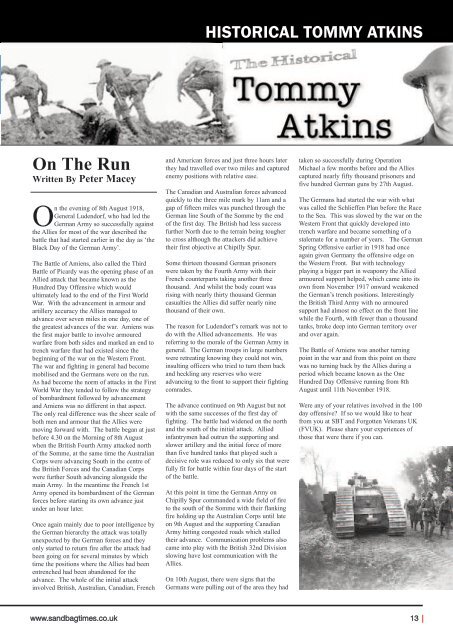The Sandbag Times Issue No: 46
The Veterans Magazine
The Veterans Magazine
Create successful ePaper yourself
Turn your PDF publications into a flip-book with our unique Google optimized e-Paper software.
HISTORICAL TOMMY ATKINS<br />
On <strong>The</strong> Run<br />
Written By Peter Macey<br />
On the evening of 8th August 1918,<br />
General Ludendorf, who had led the<br />
German Army so successfully against<br />
the Allies for most of the war described the<br />
battle that had started earlier in the day as ‘the<br />
Black Day of the German Army’.<br />
<strong>The</strong> Battle of Amiens, also called the Third<br />
Battle of Picardy was the opening phase of an<br />
Allied attack that became known as the<br />
Hundred Day Offensive which would<br />
ultimately lead to the end of the First World<br />
War. With the advancement in armour and<br />
artillery accuracy the Allies managed to<br />
advance over seven miles in one day, one of<br />
the greatest advances of the war. Amiens was<br />
the first major battle to involve armoured<br />
warfare from both sides and marked an end to<br />
trench warfare that had existed since the<br />
beginning of the war on the Western Front.<br />
<strong>The</strong> war and fighting in general had become<br />
mobilised and the Germans were on the run.<br />
As had become the norm of attacks in the First<br />
World War they tended to follow the strategy<br />
of bombardment followed by advancement<br />
and Amiens was no different in that aspect.<br />
<strong>The</strong> only real difference was the sheer scale of<br />
both men and armour that the Allies were<br />
moving forward with. <strong>The</strong> battle began at just<br />
before 4.30 on the Morning of 8th August<br />
when the British Fourth Army attacked north<br />
of the Somme, at the same time the Australian<br />
Corps were advancing South in the centre of<br />
the British Forces and the Canadian Corps<br />
were further South advancing alongside the<br />
main Army. In the meantime the French 1st<br />
Army opened its bombardment of the German<br />
forces before starting its own advance just<br />
under an hour later.<br />
Once again mainly due to poor intelligence by<br />
the German hierarchy the attack was totally<br />
unexpected by the German forces and they<br />
only started to return fire after the attack had<br />
been going on for several minutes by which<br />
time the positions where the Allies had been<br />
entrenched had been abandoned for the<br />
advance. <strong>The</strong> whole of the initial attack<br />
involved British, Australian, Canadian, French<br />
and American forces and just three hours later<br />
they had travelled over two miles and captured<br />
enemy positions with relative ease.<br />
<strong>The</strong> Canadian and Australian forces advanced<br />
quickly to the three mile mark by 11am and a<br />
gap of fifteen miles was punched through the<br />
German line South of the Somme by the end<br />
of the first day. <strong>The</strong> British had less success<br />
further <strong>No</strong>rth due to the terrain being tougher<br />
to cross although the attackers did achieve<br />
their first objective at Chipilly Spur.<br />
Some thirteen thousand German prisoners<br />
were taken by the Fourth Army with their<br />
French counterparts taking another three<br />
thousand. And whilst the body count was<br />
rising with nearly thirty thousand German<br />
casualties the Allies did suffer nearly nine<br />
thousand of their own.<br />
<strong>The</strong> reason for Ludendorf’s remark was not to<br />
do with the Allied advancements. He was<br />
referring to the morale of the German Army in<br />
general. <strong>The</strong> German troops in large numbers<br />
were retreating knowing they could not win,<br />
insulting officers who tried to turn them back<br />
and heckling any reserves who were<br />
advancing to the front to support their fighting<br />
comrades.<br />
<strong>The</strong> advance continued on 9th August but not<br />
with the same successes of the first day of<br />
fighting. <strong>The</strong> battle had widened on the north<br />
and the south of the initial attack. Allied<br />
infantrymen had outrun the supporting and<br />
slower artillery and the initial force of more<br />
than five hundred tanks that played such a<br />
decisive role was reduced to only six that were<br />
fully fit for battle within four days of the start<br />
of the battle.<br />
At this point in time the German Army on<br />
Chipilly Spur commanded a wide field of fire<br />
to the south of the Somme with their flanking<br />
fire holding up the Australian Corps until late<br />
on 9th August and the supporting Canadian<br />
Army hitting congested roads which stalled<br />
their advance. Communication problems also<br />
came into play with the British 32nd Division<br />
slowing have lost communication with the<br />
Allies.<br />
On 10th August, there were signs that the<br />
Germans were pulling out of the area they had<br />
taken so successfully during Operation<br />
Michael a few months before and the Allies<br />
captured nearly fifty thousand prisoners and<br />
five hundred German guns by 27th August.<br />
<strong>The</strong> Germans had started the war with what<br />
was called the Schlieffen Plan before the Race<br />
to the Sea. This was slowed by the war on the<br />
Western Front that quickly developed into<br />
trench warfare and became something of a<br />
stalemate for a number of years. <strong>The</strong> German<br />
Spring Offensive earlier in 1918 had once<br />
again given Germany the offensive edge on<br />
the Western Front. But with technology<br />
playing a bigger part in weaponry the Allied<br />
armoured support helped, which came into its<br />
own from <strong>No</strong>vember 1917 onward weakened<br />
the German’s trench positions. Interestingly<br />
the British Third Army with no armoured<br />
support had almost no effect on the front line<br />
while the Fourth, with fewer than a thousand<br />
tanks, broke deep into German territory over<br />
and over again.<br />
<strong>The</strong> Battle of Amiens was another turning<br />
point in the war and from this point on there<br />
was no turning back by the Allies during a<br />
period which became known as the One<br />
Hundred Day Offensive running from 8th<br />
August until 11th <strong>No</strong>vember 1918.<br />
Were any of your relatives involved in the 100<br />
day offensive? If so we would like to hear<br />
from you at SBT and Forgotten Veterans UK<br />
(FVUK). Please share your experiences of<br />
those that were there if you can.<br />
www.sandbagtimes.co.uk 13 |


















